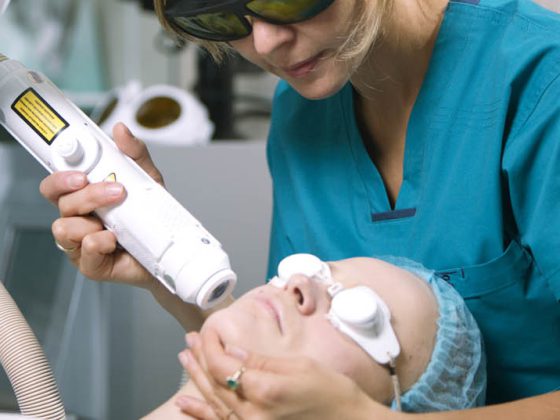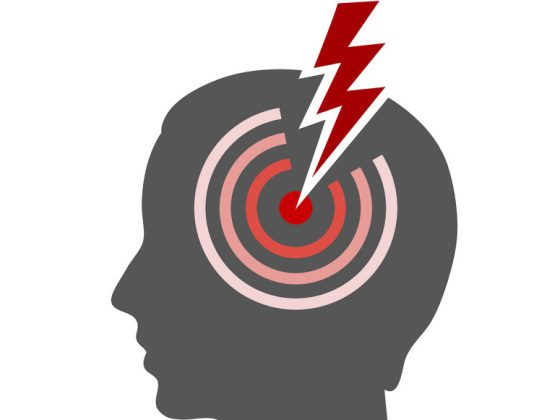Transition of adolescents with congenital heart disease is a continuous and interdisciplinary process. Individual maturity and autonomy of patients influence the course of the transition process (“no absolute age limits”). Transition is designed to empower young adults to take understanding and responsibility for their condition. The transition process is designed to prevent youth with an AHF from falling through the medical cracks. Successful transition increases compliance and disease understanding in adulthood for lifelong cardiology care by specialized practitioners. Successful transition should lead to earlier diagnosis of deterioration in young adults with a congenital heart defect, improving long-term prognosis.
Thanks to advances in pediatric cardiology and pediatric cardiac surgery over the past twenty years, survival rates and long-term prognosis of children even with complex congenital heart defects (AHF) have improved such that more than 90% of patients now reach adulthood. Currently, there are more adults than children living with AHF worldwide who require lifelong cardiac follow-up because, depending on the complexity of the AHF, there is sometimes a high risk of late complications with the need for surgical or catheter interventional reinterventions [1].
These new challenges in the long-term care of adolescents and young adults with an AHF are addressed by the concept of a continuous transition process in the care of this patient group.
Transition in this context means medical and all aspects of life continuous and individualized care of adolescents into adulthood by pediatric cardiologists, with early involvement of GUCH cardiologists (Grown Ups with Congenital Heart Disease) and, if possible, a specialized care team. Improving the patient’s and family’s understanding of their own situation and treatment options should increase compliance with regard to required cardiac monitoring. As a result, clinical deterioration can be diagnosed and treated earlier, and active life planning can improve overall quality of life [2].
Broad spectrum of medical sequelae after therapy of AHF
Patients with an AHF may develop various cardiac and general health problems in the long-term course (Tab. 1). After corrective surgery in the neonatal or infant period, reoperations or catheter interventions may be required over the course of years to treat residuals, new cardiac findings, or arrhythmias. Therefore, the long-term prognosis is significantly influenced by early diagnosis and optimal treatment planning [3]. In contrast, emergency presentations are associated with increased morbidity and mortality due to lack of cardiac follow-up [4].
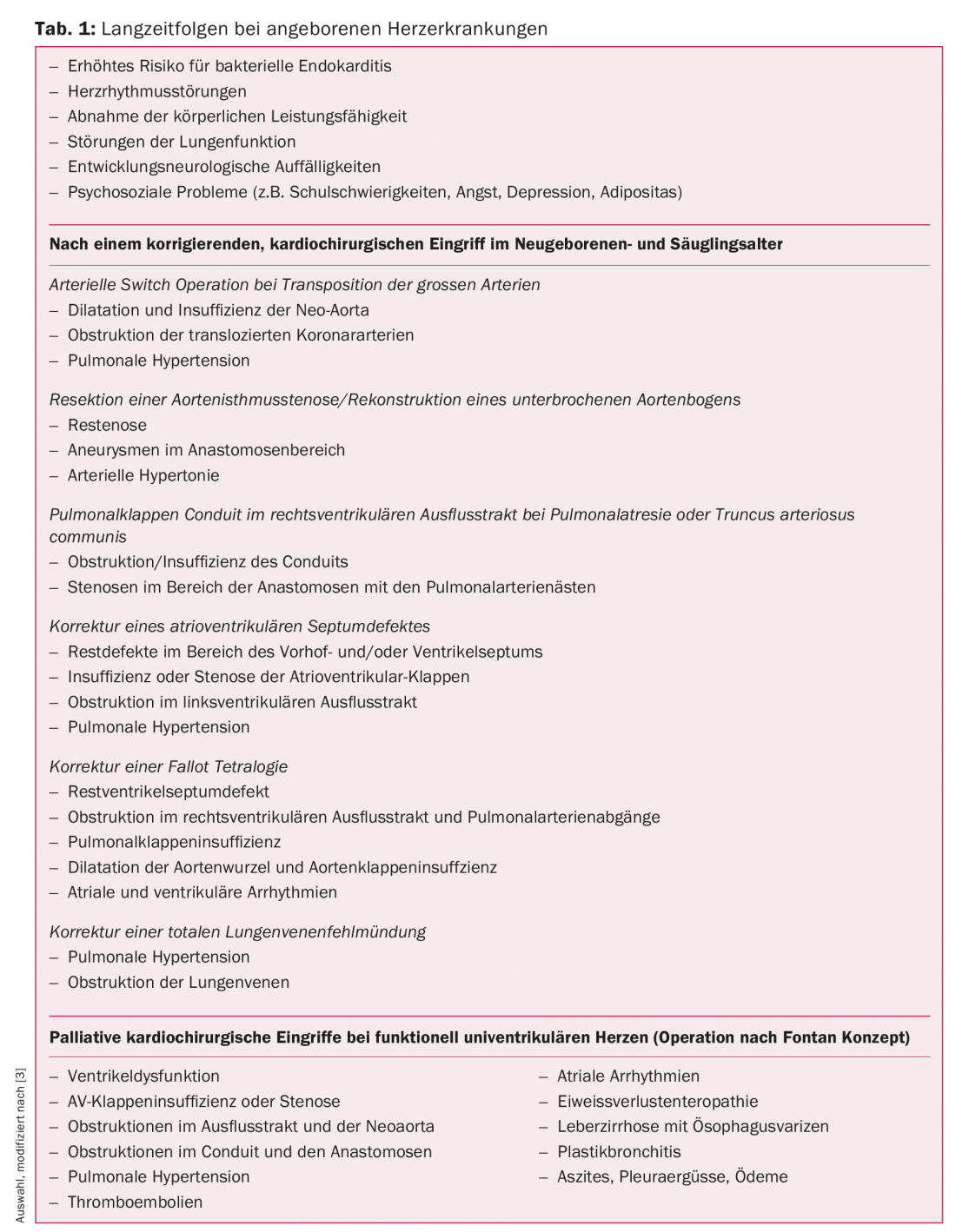
A continuous, individual and interdisciplinary process
Goal of the transition process: During the transition process, adolescents with an AHF should gain a comprehensive understanding of their health situation and gradually assume greater personal responsibility, taking into account their personal maturity. Transition therefore encompasses medical, social, psychological and insurance aspects [2,5].
Selection of important medical topics addressed in the transition process.
Understanding of one’s own heart disease: During outpatient check-ups, the heart defect and the therapies that have taken place so far are repeatedly explained, taking into account current findings. If desired, additional information material can be provided (e.g. information about self-help groups in Switzerland such as Cuore Matto) and the adolescent is actively encouraged to ask questions about his or her heart disease.
The indication as well as the correct dosage and potential side effects of medications should be discussed at regular intervals. As the adolescent becomes more autonomous, he will take responsibility for taking his medication regularly. Thus, for example, renewed training in self-monitoring of oral anticoagulation is also useful.
The need for lifelong health care, especially cardiac follow-up, and its typical time intervals are discussed.
Raise awareness of signs of clinical deterioration and recognize warning symptoms: adolescents should be increasingly educated about possible clinical signs of deterioration (i.e., decreased performance, arrhythmias), their significance, and initial actions.
Repeat cardiac interventions and risk of non-cardiac surgery: potential indications for catheter interventional/surgical procedures are addressed and, if necessary, planned with the adolescent and family. Questions regarding the long-term perspective will also be discussed. This approach should help to avoid interruptions in cardiac follow-up during the transition from adolescence to adulthood. In addition, if noncardiac surgery is required, the perioperative risk of AHF should be evaluated early and appropriate preventive measures should be included in the planning (e.g., optimizing the cardiac situation, planning the surgical procedure in a center for congenital heart defects).
Education about the risks, symptoms and preventive measures of bacterial endocarditis: Of great clinical relevance is education about the correct indications for endocarditis prophylaxis (special cards from the Swiss Heart Foundation are available in all national languages), the need for good dental hygiene and the use of regular dental prophylaxis. Adolescents with the desire to have tattoos or piercings require intensive education about the additional risks involved and the importance of proper skin disinfection and care.
Role of exercise in AHF: Taking into account the heart defect and current cardiac status, the benefits of regular exercise should be emphasized, and the adolescent should be helped to choose an appropriate sport. Regular recording of individual performance, preferably by means of spiroergometry on a treadmill or bicycle, allows specific recommendations to be made in the choice of a suitable recreational sport and training recommendations [6].
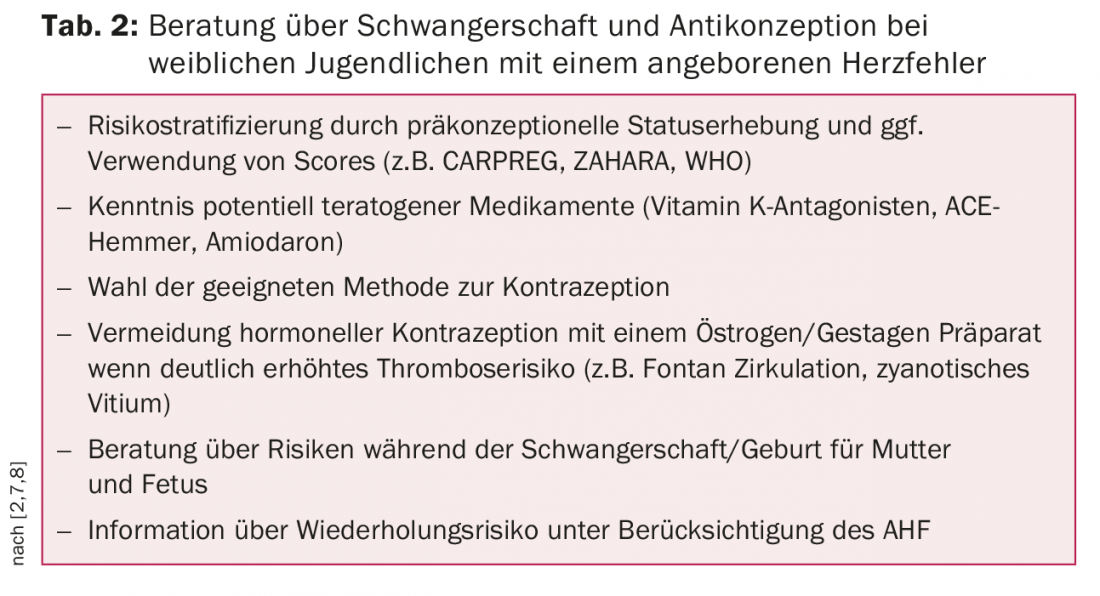
Family planning with anticonception, evaluation of risks of pregnancy and genetic counseling: For all young people, aspects of family planning are also addressed at an early stage, taking into account individual personal maturity, current life situation and social background (Tab.2). Young women are advised to inform their gynecologist about the AHF so that an appropriate method of anticonception can be chosen under individual risk assessment. If pregnancy is desired, planning ideally begins preconceptually in that potentially teratogenic drugs can be exchanged for safe drugs or even cardiac status can be optimized by surgical/interventional procedures (e.g., patients with Marfan syndrome and borderline dilatation of the aortic bulb, patients with borderline findings of valvular heart disease). Women with a complex heart defect should be counseled about the individual risks to the mother and the fetus, as well as the risk of recurrence, preconception if possible [7,8].
Practical organization of the transition process: In order to meet these numerous needs, an interdisciplinary approach is helpful, which requires a high degree of professional competence and communication skills from all professional groups involved – i.e. pediatric cardiologists, GUCH cardiologists, and nursing experts (“advanced practice nurses”). A selection of common common themes in the transition process is summarized in Table 3 .
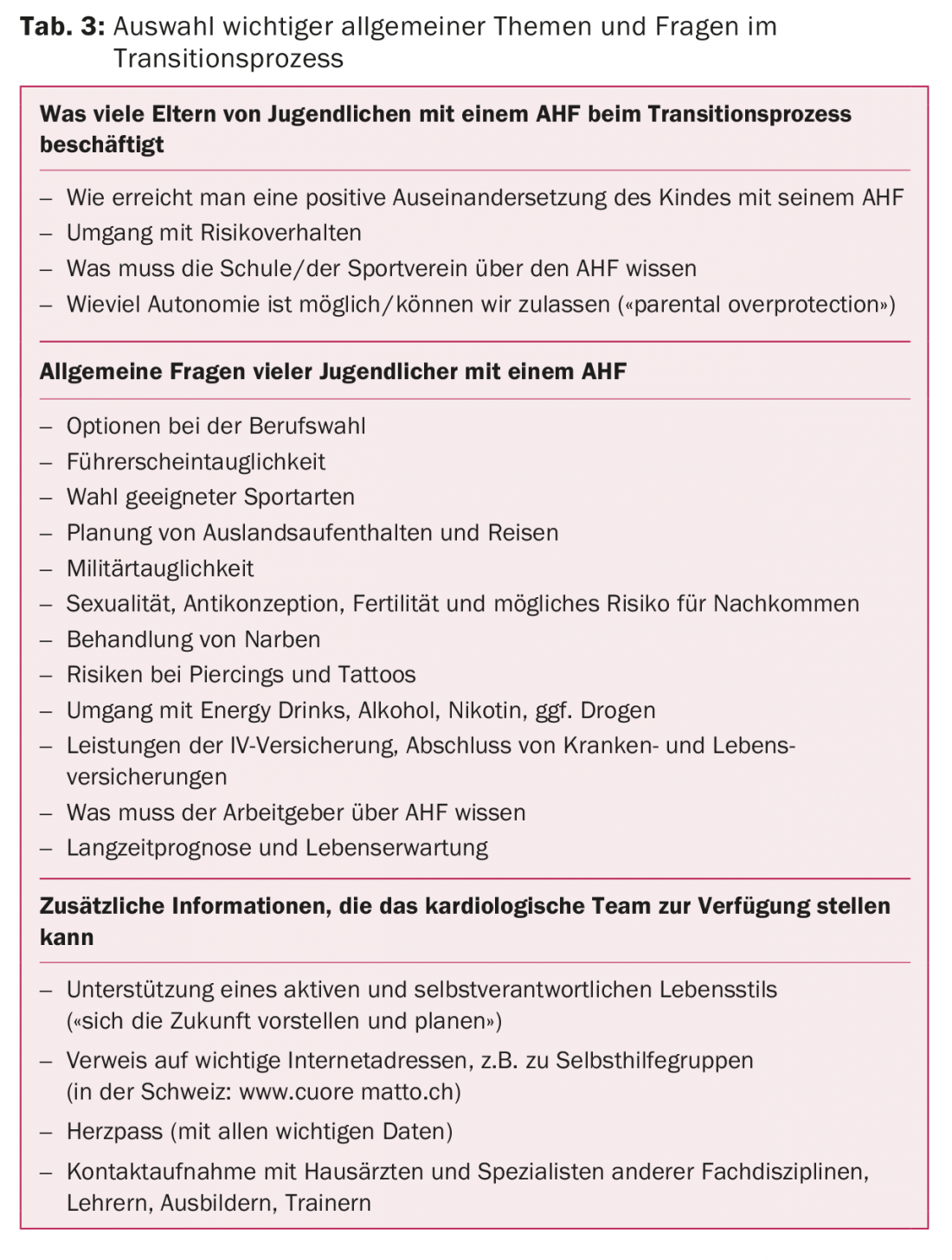
In addition to the family’s joint consultation appointments with the pediatric cardiologist and the GUCH cardiologist who continues to provide care, nursing experts with a specialization in congenital heart defects are also increasingly assuming important coordinating functions in the transition process (Table 4) . Ideally, the transition process begins between the ages of 11 and 13. With the transfer of the young adult to further care by the GUCH cardiologist, all important documents regarding the course of the disease (especially reports of surgery, cardiac catheter interventions, findings of imaging diagnostics, reports of pacemaker programming, stress tests, biomarkers and CDs with image material) should be passed on.
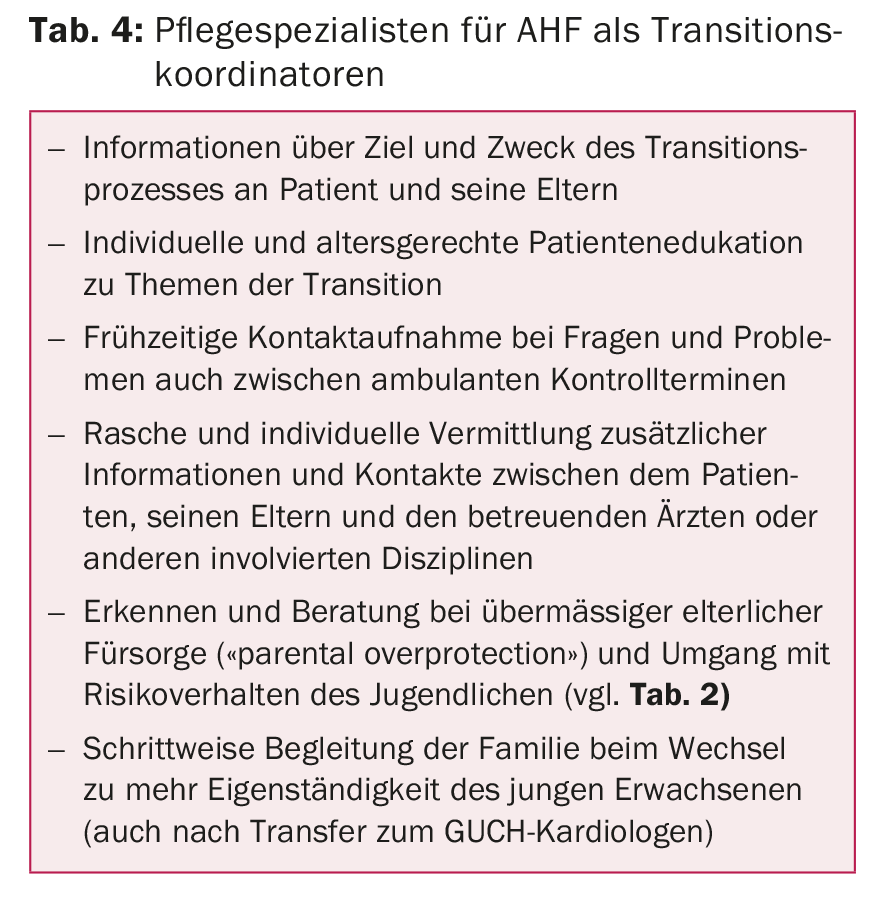
Recently, a jointly authored position paper was published for this patient group by the Swiss Working Group for Adults and Teenagers with Congenital Heart Disease (WATCH), which will contribute to a standardization of care for this patient group (Table 5) [9].
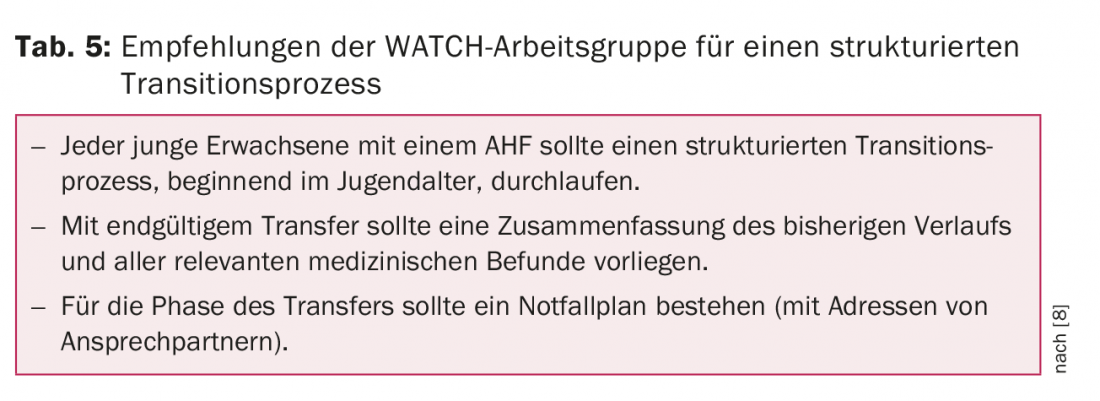
What can data from the patient registry and clinical trials do for transition?
Evaluations of the patient registry of the WATCH group on the long-term course of GUCH patients suggest important impulses for the optimal care of patients with an AHF in the phase of transition in Switzerland. Current international studies evaluate to what extent a structured transition, consisting of a team of nursing experts (“advanced practice nurses”), pediatric cardiologists, and GUCH cardiologists, can positively influence the further clinical course with regard to various parameters [10,11].
Literature:
- Marelli AJ, et al: Lifetime prevalence of congenital heart disease in the general population from 2000 to 2010. Circulation 2014; 130: 749-756.
- Sable C, et al: Best practices in managing transition to adulthood for adolescents with congenital heart disease: the transition process and medical and psychosocial issues: a scientific statement from the American Heart Association. Circulation 2011; 123: 1454.
- Wernovsky G, et al: Creating a lesion-specific “roadmap” for ambulatory care following surgery for complex congenital cardiac disease. Cardiol Young Jul 4 2016; 1-15. [Epub ahead of print]
- Goossens E, et al: Predictors of care gaps in adolescents with complex chronic condition transitioning to adulthood. Pediatrics 2016; 137: e20152413.
- Warnes CA, et al: ACC/AHA 2008 guidelines for the management of adults with congenital heart disease. Circulation 2008; 118: e714-e833.
- Takken T, et al: Recommendations for physical activity, recreation sport, and exercise training in paediatric patients with congenital heart disease. Eur J Prev Cardiol 2012; 19: 1034-1065.
- Silversides CK, et al: Choosing the best contraceptive method for the adult with congenital heart disease. Curr Cardiol Rep 2009; 11: 298-305.
- Lindley KJ, et al: Contraception and pregnancy planning in women with congenital heart disease. Curr Treat Options Cardio Med 2015; 17: 50.
- Bouchardy J, et al: Grown-up congenital heart disease. Cardiovasc Med 2015; 18(4): 144-145.
- Mackie AD, et al: A cluster randomized trial of a transition intervention for adolescents with congenital heart disease: rationale and design of the CHAPTER 2 study. BMC Cardiovascular Disorders 2016; 16: 127.
- Harbison AL, et al: Provision of transition education and referral patterns from pediatric cardiology to adult cardiac care. Pediatr Cardiol 2016; 37: 232.
CARDIOVASC 2016; 15(5): 10-14


